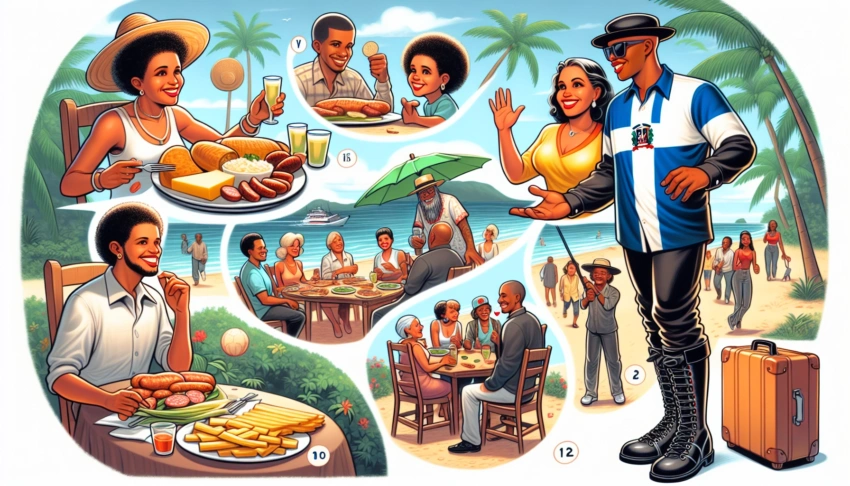Navigating Cultural Differences: Dominican Etiquette and Customs to Know Before You Go
Understanding Dominican Social Norms

Navigating Cultural Differences: Dominican Etiquette and Customs to Know Before You Go
Understanding the social norms of the Dominican Republic is your golden ticket to an immersive and rewarding travel experience. The warmth and friendliness of the Dominican people are legendary, and knowing how to navigate these cultural waters will enrich your journey and create unforgettable memories.
1. Friendly and Warm Greetings
In the Dominican Republic, greetings are more than just a formality; they are an essential part of the social fabric. The Dominicans are known for their friendly and vibrant nature, and this is evident in their greetings. Whether you’re meeting someone for the first time or greeting a familiar face, a warm, heartfelt approach is customary.
Common Phrases and Gestures
When entering a room, it’s customary to greet everyone individually. A simple “Hola” (Hello) or “¿Cómo estás?” (How are you?) can suffice, but if you’re looking to make a lasting impression, try “¡Qué lo qué!”—a colloquial way of saying “What’s up?” among friends. Accompany these verbal greetings with a friendly handshake or a kiss on the cheek, especially if you’re meeting women or close friends.
Be prepared for longer-than-usual greetings; Dominicans love to chat! Embracing this practice is a great way to connect and show respect. Remember, your smile is your best accessory—let it shine brightly!
2. Respect for Elders and Authority
In Dominican culture, respecting elders and authority figures is deeply ingrained. This respect is woven into the fabric of daily life and is evident in how people interact with one another.
Interactions and Language
When addressing elders or authority figures, it’s important to use formal titles such as “Don” or “Doña” followed by their first name. This shows reverence and acknowledges their status. Additionally, using polite expressions like “Por favor” (Please) and “Gracias” (Thank you) is essential, not just with elders but in all interactions.
A particularly endearing trait of Dominican culture is the way younger generations look after their elders, often living in multigenerational households where family ties are cherished and respected.
3. The Concept of ‘Dominican Time’
The idea of ‘Dominican Time’ is an intriguing aspect of life on this vibrant island. It reflects a more relaxed approach to timekeeping, where punctuality is flexible, and being fashionably late is often the norm.
Impact on Social and Business Settings
In social settings, arriving 15 to 30 minutes late is typically acceptable and even expected. This relaxed approach extends to business meetings, though it’s always advisable to be a bit more punctual in professional contexts to show respect and professionalism.
Understanding this cultural nuance can save you from unnecessary stress. Embrace it as part of the Dominican charm, and you’ll find yourself slipping into the island’s easygoing rhythm.
As you navigate the cultural landscape of the Dominican Republic, keep in mind that the ultimate goal is to enjoy and engage with the people and their traditions. By understanding and respecting these social norms, you’ll not only enhance your travel experience but also forge meaningful connections with the locals.
Dining Etiquette in the Dominican Republic
Embarking on a culinary journey in the Dominican Republic is much more than just savoring delicious food; it’s about immersing yourself in the rich tapestry of local customs and traditions that accompany every meal. Understanding dining etiquette here is key to truly appreciating the local culture and ensuring your experiences are both enjoyable and respectful.
1. Traditional Meals and Dining Hours
In the Dominican Republic, meals are a vibrant celebration of culture and tradition. The day typically begins with a light breakfast, often consisting of tropical fruits, fresh bread, and coffee. Lunch, or “la comida”, is the most significant meal of the day, usually served between noon and 2 PM. It often features a hearty spread of rice, beans, meat, and salad.
Dinner is generally lighter and served later in the evening, around 7 to 9 PM. Traditional dishes like mangu (mashed plantains), sancocho (hearty stew), and arroz con pollo (chicken with rice) are common. Each meal is a reflection of the island’s diverse culinary influences, from Spanish to African, making every bite a delightful experience.
2. Table Manners and Taboos
When dining in the Dominican Republic, table manners echo the country’s warm and hospitable nature. It’s customary to wait for the host to say “buen provecho” (enjoy your meal) before beginning to eat. Using utensils for most foods is expected, although certain dishes like fried plantains can be enjoyed with hands.
Avoid placing elbows on the table, as it is considered impolite. Compliments to the cook are always appreciated, and expressing enjoyment of the meal is a great way to show respect. On the flip side, it’s best to avoid discussing politics or controversial topics at the table, as these can dampen the jovial spirit of the meal.
3. Socializing Over Meals
Meals in the Dominican Republic are more than just about food; they are social events that foster connection and community. It’s common for meals to be accompanied by lively conversation and laughter. Dominicans are known for their hospitality, and guests are often treated like family. Participating in the conversation and showing genuine interest in your hosts’ stories enhances the dining experience.
Dining out is also a social affair, whether in bustling “comedores” (local eateries) or upscale restaurants. Sharing dishes is a common practice, and it’s perfectly acceptable—and encouraged—to try a bit of everything. This not only allows you to taste a variety of flavors but also demonstrates your enthusiasm for the local cuisine.
Our Best Culinary Tours in the Dominican Republic
To truly savor the flavors of the Dominican Republic, consider joining one of our curated culinary tours. These excursions offer a unique opportunity to experience the country’s rich gastronomic traditions first-hand, all while exploring local markets and enjoying meals with local families.

Saona Island Excursion - Caribbean Paradise
from $75 Read more
Swimming with Dolphins in Punta Cana - Top Adventure 2025 (50 minutes)
from $149 Read moreDress Code and Appearance
When stepping into the vibrant world of the Dominican Republic, understanding the cultural nuances of dress and appearance can significantly enhance your experience. From casual beach outings to formal gatherings, how you present yourself can make a lasting impression.
1. Casual vs. Formal Attire
In the Dominican Republic, attire varies greatly depending on the occasion and location. On the island’s sun-kissed beaches, casual attire such as shorts, tank tops, and flip-flops are the norm. However, when you venture into the city or attend social gatherings, the dress code tends to be more elegant and polished. Dominicans take pride in their appearance, often dressing up for dinners or nights out.
For men, this might mean a crisp shirt and well-fitted trousers, while women often opt for stylish dresses or skirts. It’s worth noting that even in casual settings, Dominicans tend to dress with care. It’s a culture where looking “put together” is appreciated, reflecting respect for oneself and others.
2. Cultural Significance of Appearance
Appearance holds a significant cultural value in the Dominican Republic. It is seen as a reflection of one’s respect for the event or people involved. This cultural emphasis on appearance extends beyond clothing to include grooming and personal hygiene. Dominicans pay close attention to their hair and accessories, making sure everything is in place before stepping out.
The importance placed on appearance is not just about vanity; it’s deeply rooted in cultural traditions. Making a good impression is seen as a form of respect, and dressing appropriately shows that you value the people and situations you are engaging with. This cultural norm is particularly evident in business settings, where a professional appearance can speak volumes about your reliability and seriousness.
3. Appropriate Attire for Religious Visits
When visiting religious sites in the Dominican Republic, such as churches or cathedrals, dressing modestly is crucial. These are sacred places where respect is paramount. For both men and women, this means wearing clothes that cover the shoulders and knees. Avoid wearing hats inside religious buildings, and women may consider carrying a shawl or scarf to cover their heads if required.
Remember that dressing appropriately for religious visits is not just about following guidelines; it’s a sign of respect for the local culture and religious sentiments. This small gesture can go a long way in creating a positive impression and enhancing your experience.
Cultural Dress Comparisons in the Dominican Republic
| Setting | Casual Attire | Formal Attire | Religious Visits |
|---|---|---|---|
| Beach | Swimwear, shorts, sandals | N/A | N/A |
| City Outing | Jeans, t-shirt, sneakers | Shirt, dress, stylish shoes | N/A |
| Business Meeting | N/A | Suit, tie, dress shoes | N/A |
| Religious Site | N/A | N/A | Modest dress, covered shoulders |
Embracing the local dress code not only helps you blend in but also opens up a world of warm interactions. Dominicans appreciate when visitors respect and acknowledge their cultural norms, leading to more meaningful connections.
Navigating Public and Private Spaces
Understanding the nuances of interacting in public and private spaces is crucial when visiting the Dominican Republic. From the bustling streets of Santo Domingo to the intimate gatherings in local homes, knowing the cultural etiquette will ensure a respectful and immersive experience.
1. Public Transportation Etiquette
The public transportation system in the Dominican Republic is vibrant and often bustling with activity. From guaguas (buses) to carros públicos (shared taxis), each mode of transport comes with its own set of unwritten rules.
When using public transportation, it is customary to greet the driver with a friendly “buen día” or “buenas tardes” as you board. This small gesture goes a long way in creating a pleasant atmosphere. Additionally, be prepared for close quarters as personal space is more relaxed; this is often seen as an opportunity for friendly conversation rather than an invasion of privacy.
Public Transportation Tips
| Transport Type | Greeting | Seating Etiquette | Payment Method |
|---|---|---|---|
| Guagua (Bus) | Say hello to the driver | Find a seat quickly, expect to share space | Pay in cash upon entering |
| Carro Público (Shared Taxi) | Greet the driver and passengers | Be prepared to share the back seat | Pay in cash at the end of the journey |
Remember, patience is key, as schedules can be unpredictable. Instead, enjoy the ride as a cultural experience, and you might even get some valuable local insights from your fellow passengers!
2. Visiting Homes and Gift Giving
Visiting a Dominican home is a wonderful opportunity to experience the warmth and hospitality of the local people. When invited, it is customary to bring a small gift as a token of appreciation. This could be a bottle of wine, a box of chocolates, or a bouquet of flowers. Such gestures are not only polite but also a way to express gratitude for the invitation.
Upon entering the home, be sure to greet everyone present with a handshake or a cheek kiss, a common practice in Dominican social settings. Engage in light conversation and be prepared to enjoy a meal or some refreshments, as Dominicans are known for their generous hospitality.
Recommended Tours for Cultural Immersion
If you’re keen to dive deeper into the local culture, consider booking a tour that offers authentic experiences in the Dominican Republic. Our curated excursions provide a perfect blend of adventure and cultural exploration.

Punta Cana Private Boat Trip at the Best Price - 3-Hour Exclusive Tour with Snorkeling (from Jellyfish to Cabeza de Toro)
from $590 Read more
Power Cruise – Punta Cana Party Experience on the Bad Girl Catamaran
from $65 Read more3. Respecting Personal Space
Dominican culture values closeness and warmth in social interactions, which extends to their perception of personal space. Unlike in some Western cultures, where maintaining a certain distance is the norm, Dominicans often stand closer and are more tactile. This approach is not intrusive but rather a reflection of their friendly nature.
When engaging in conversation, don’t be surprised if a local touches your arm or stands closer than you might be used to. This behavior signifies friendliness and openness. Similarly, when navigating crowded markets or events, maintaining a relaxed attitude about personal space will help you blend in seamlessly.
By understanding and respecting these cultural nuances, you’ll not only avoid potential faux pas but also enrich your travel experience with meaningful interactions and insights into Dominican life.
Unique Cultural Practices
The Dominican Republic is a vibrant tapestry of cultural practices that offer a window into its rich heritage and lively social life. From rhythmic dances to the national passion for baseball, understanding these unique traditions can enhance your travel experience.
1. Merengue and Bachata Dance Etiquette
Dancing in the Dominican Republic is more than just an art form—it’s a way of life. Merengue and Bachata, the country’s most famous dances, are deeply embedded in the culture. Merengue, with its quick steps and lively beats, originated in the Dominican Republic and is a staple at any celebration. Bachata, known for its romantic sway, is another beloved dance that reflects the island’s rhythm and soul.
When participating in these dances, understanding the unspoken rules is crucial. It’s common courtesy to greet your dance partner with a smile and maintain eye contact throughout the dance, demonstrating engagement and respect. The pace and style of dancing often vary, so it’s polite to follow your partner’s lead, especially if you’re new to the dance floor. Remember, the goal is to have fun and enjoy the music, so don’t be shy about joining in!
2. The Role of Baseball in Dominican Culture
Baseball isn’t just a sport in the Dominican Republic; it’s a national obsession that brings communities together. The country has produced some of the world’s best baseball players, and local games can be as thrilling as any major league matchup. Baseball games are social events where families gather, friendships are forged, and local pride is on full display.
Attending a game offers a unique insight into Dominican life. The atmosphere is electric, with music, chanting, and vibrant displays of team spirit. Visitors are encouraged to join in the excitement, cheer for the teams, and even participate in friendly banter with local fans. It’s an excellent opportunity to engage with the community and experience Dominican hospitality firsthand.
3. Celebrations and Festivals
The Dominican Republic is home to a myriad of celebrations and festivals that reflect its cultural diversity and joyous spirit. From colorful carnivals to religious festivals, each event is a spectacular display of tradition, music, and dance.
One of the most famous is the Carnival, celebrated in February, where towns and cities burst into color with parades, music, and elaborate costumes. Participating in these festivals offers a chance to witness the Dominican community’s vibrant energy. It’s important to respect local customs during these events, such as not obstructing parade routes and being mindful of personal space amid the bustling crowds.
Understanding and respecting these unique cultural practices can significantly enhance your experience in the Dominican Republic, allowing you to immerse yourself fully in the local way of life.
Frequently Asked Questions
When planning your adventurous journey to the vibrant Dominican Republic, it’s crucial to be informed about local customs and etiquette to ensure a seamless and enriching experience. Here, we address some of the most frequently asked questions by travelers, offering insights that will help you blend in and enjoy your stay to the fullest.
1. What is the typical way to greet someone in the Dominican Republic?
Greetings in the Dominican Republic are more than just a formality; they are a warm and welcoming ritual. Typically, a handshake is common in formal settings, but among friends and family, a friendly kiss on the cheek is the norm. This gesture reflects the warmth and hospitality that Dominicans are known for. Remember to smile and maintain eye contact to convey sincerity and openness.
2. How important is punctuality in the Dominican Republic?
The concept of “Dominican Time” is something every traveler should be aware of. Unlike the fast-paced, punctual nature of Western cultures, Dominicans have a more relaxed approach to time. Being slightly late — say, 15 to 30 minutes — is generally acceptable in social settings. However, it’s best to be punctual for business meetings and formal events to demonstrate respect and professionalism.
Our Best Tours in the Dominican Republic
Embark on an unforgettable adventure with our exclusive tours that allow you to experience the heart of Dominican culture. From vibrant city explorations to serene beach retreats, discover the best of what this tropical paradise has to offer. Book now to secure your spot on these popular excursions!

La Hacienda Park - 7-in-1 Adventures Tour in Bávaro, Punta Cana
from $99 Read more
Scape Park in Punta Cana - Full Admission
from $129 Read more3. What is considered rude when visiting a Dominican home?
When visiting a Dominican home, don’t arrive empty-handed. It’s customary to bring a small gift, such as a bottle of wine or sweets, as a token of appreciation. Additionally, make sure to greet everyone present upon arrival. Skipping greetings or leaving someone out can be seen as impolite.
4. Is it necessary to tip in restaurants?
Yes, tipping is customary in the Dominican Republic, and it’s a way to show appreciation for good service. A tip of around 10% of the bill is standard, although some restaurants may include a service charge, so it’s wise to check your bill first. Leaving a small tip even if service is included is considered polite.
5. How should I dress when visiting a church?
When visiting religious sites, modest attire is expected as a sign of respect. Ensure that your clothing covers your shoulders and knees. Dominicans take pride in their religious traditions, and dressing appropriately is a way to honor these customs and show reverence.
6. Are there any taboos in Dominican culture?
While Dominicans are generally open and friendly, certain topics are best avoided. Discussing politics or making negative remarks about the country can be sensitive. Focus on positive interactions and steer clear of controversial discussions to maintain harmony.
7. What are common gift-giving practices?
Gift-giving is an integral part of Dominican hospitality. When visiting someone’s home, bringing a gift like wine or chocolates is a thoughtful gesture. It shows appreciation and respect for your host’s generosity.
8. Can I take photos of people without asking?
Before capturing the lively spirit of Dominican people in your photos, always ask for permission. This simple courtesy is appreciated and helps you engage positively with locals. Remember, a smile can go a long way when requesting a photo.
9. How do Dominicans view personal space?
Personal space in the Dominican Republic is more relaxed than in many Western cultures. Physical proximity is common in social interactions, and friendly gestures such as hugs are not unusual. Embrace the warm, close-knit nature of Dominican culture, and you’ll feel right at home.
10. What should I know about local transportation etiquette?
When using local transportation, such as taxis and buses, it’s polite to greet the driver with a simple “Buenos días” or “Buenas tardes.” Additionally, be considerate to fellow passengers by keeping noise levels down and offering your seat to those in need. This shows respect and courtesy, essential traits in Dominican society.
